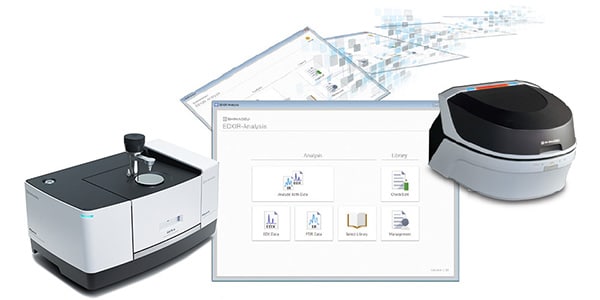LabSolutions IR - Options
Analytical Data System for FTIR
Software Options
Time course software

The time course program is used to collect spectra in regular intervals and creates a time course dataset used to follow reactions as a function of time. Changes in peak height and peak area can be used to calculate values related to reaction kinetics.
Time course information is saved and displayed in 3D (bird's eye view) or in a contour plot. It can be recalculated by modifying parameters.
The scan interval is dependent on resolution, number of scans and mirror speed.
The fastest speed under a 16cm-1 resolution and a mirror speed of 9mm/s is 7 seconds for 1 accumulated scan. The time course software includes a 3D Presentation function.
Mapping program
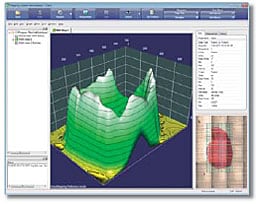
The Mapping software allows one to map absorption information on a sample surface as a function of position when using the SHIMADZU AIM-8800 Infrared Microscope.
Mapping parameters, such as the mapping range, the scan intervals, and the background positions, can be set on the composite images. Area mapping, line mapping and random mapping modes are supported.
In addition to mapping in the conventional transmittance and reflectance modes, micro-ATR mapping with an optional ATR objective is also available. From the acquired mapping data, it is possible to extract spectra and to perform calculations for functional-group mappings for specific peaks. The data can be displayed as 3D images or contour plots, or in spectral overlay mode. Mapping program includes a 3D Presentation function.
PLS Quantitation program

PLS (partial least squares) quantitation is a chemometrics method that, like multiple linear regression analysis, is widely used for the simultaneous quantitation of multiple components. The PLS quantitation program incorporates PLS I and PLS II methods. It is possible to display calculation values based on input values. PLS factors are based on "PRESS" values, loading vectors, and score values. Analysis can be performed on the regression equations obtained with the PLS method.
Curve-Fitting (Peak-Splitting) program
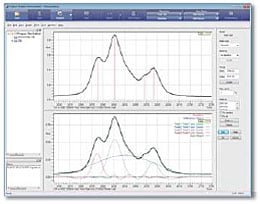
Usually, absorption bands in infrared spectra consist of overlapping peaks. The curve-fitting (peak-splitting) program can be used to separate absorption bands into individual peaks, separate peaks that have been influenced by hydrogen bonding, and identify the peaks of functional groups that are hidden by absorption bands. Six types of curves, such as Gaussian, Lorentzian, and Gaussian+Lorentzian, are available for separation analysis. The curve can be selected in accordance with the form of the peaks in the absorption band. The separated component peaks are displayed together with the resultant spectra, making it possible to accurately evaluate the separation.
3D presentation program

* The 3D display program cannot control mapping measurements or AIM-8800 series infrared microscopes.
The 3D presentation program offers the following functionality
Changes the method of displaying data
- Data can be displayed in bird's eye view (3D), as an intensity distribution or using contour lines, as a spectral overlay, or rotated.
3D data processing
- Changes at specific wavenumbers can be isolated.
- Functions include data extraction, data points thinning, smoothing,zero-baseline, background correction, normalization, log conversion, first- or second-order derivative, and ATR correction.
Creation of 3D data from spectra
- Spectra measured at fixed intervals, such as by repeated measurements, can be arranged consecutively to create 3D data.
Macro Platform
The Macro Platform is required to run the customized macro programs created by SHIMADZU (for a fee). If, for example, you wish to perform routine work in which certain functions are used in a pre-determined order, or you wish to run an automatic measurement system in combination with an auto sample changer, please contact your SHIMADZU representative for details.
UV-Damaged Plastics Library

When analyzing plastics, libraries are used to qualify their material properties. However, infrared spectra of plastics that have been denatured (have deteriorated) due to UV rays differ in shape from standard spectra, and qualifying them can sometimes be difficult.
To address this, UV-Damaged Plastics Library, so highly accurate qualification can be performed reflecting the state of deterioration.
Features
- This proprietary Shimadzu library includes the IR spectra for plastics degraded by UV rays for the equivalent of approximately 10 years using a super accelerated weathering chamber from Iwasaki Electric Co., Ltd.
- This library includes more than 300 spectra from the UV degradation of 14 types of plastic.
Applicable Fields
- Food, pharmaceutical, petroleum, chemical, and other fields where Contaminants analysis is performed
- Organizations performing contracted analyses, research institutes (microplastic analysis)
* There is no function to determine the degree of deterioration. This library contains infrared spectra differing with respect to the UV irradiation time. However, the irradiation conditions noted in the data matches from library searches of the analyzed samples measured are at best reference values. Be aware that they do not indicate that the sample was placed under identical conditions.
Thermal-Damaged Plastics Library
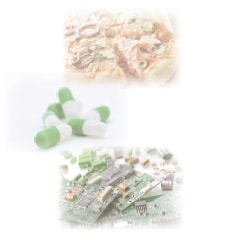
Troubles caused by contaminants in Foods, Pharmaceuticals, Electricals and Electronics, Machineries, and more fields frequently happens. There are many kinds of contaminants. A part of plastics damaged by age, heating, and other factors is a reason of contaminants.
FTIR is suitable to identify such plastics contaminants. But the shape of infrared spectra of thermally damaged (oxidized) plastics is different from that of the original spectra. Therefore, they are not found in commercially polymer libraries or tend to show a similar but different spectrum even if they are found. For this reason, it is difficult to identify or qualitatively determine such plastics.
Thermal-Damaged Plastics Library contains spectra of plastics oxidized by heating. It is exceptionally effective for analysis of unknown samples such as thermally changed contaminants and defective products that commercial libraries cannot cover.
Features
- Shimadzu's unique library containing IR spectra of plastics damaged by heating. Thermal-Damaged Plastics Library was created using spectra obtained by Hamamatsu Technical Support Center, Industrial Research Institute of Shizuoka Prefecture.
- Includes data of 13 types of plastics unheated and damaged by heating at 200 to 400 degree C.
- Spectra in the library was obtained by Infrared microscope-Transmittance mode, but combination of a single bound ATR method and an Advanced ATR correction makes excellent spectral search.
Applicable Fields
- Food, pharmaceutical, Electricals and Electronics, petroleum, chemical, and other fields where Contaminants analysis is performed
- Organizations performing contracted analyses
Shimadzu created Thermal-Damaged Plastics Library using spectra obtained by Hamamatsu Technical Support Center, Industrial Research Institute of Shizuoka Prefecture.
Analysis of Contaminants on a plated part
Semi-translucent tan contaminants were found on a plated part. IR spectra of the contaminant was so complicated and similar spectra could not be searched with commercial polymer libraries. Searching with the Thermal-Damaged Plastics Library found that it was heated and oxidized polyethylene. A chip of packing bag made of polyethylene of the part was attached the part. Then, it is heated and oxidized on next heating process
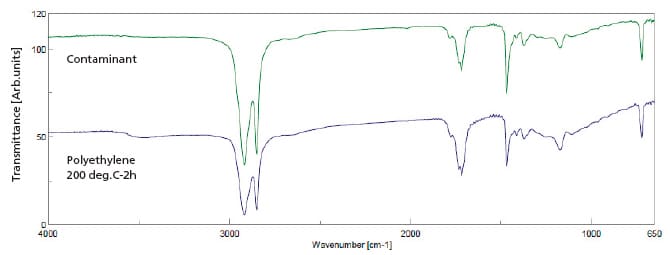

Similar product: EDXIR-Analysis Contaminant Finder/Material Inspector
EDXIR-Analysis software is specially designed to perform qualitative analysis using data acquired by an energy dispersive X-ray (EDX) fluorescencespectrometer and a Fourier transform infrared spectrophotometer (FTIR). This software is used to perform an integrated analysis of data from FTIR, which is excellent at the identification and qualification of organic compounds, and from EDX, which is excellent at the elementary analysis of metals, inorganic compounds and other content. It then pursues identification results and the degree of matching. it can also be used to perform EDX or FTIR data analysis on its own. The library used for data analysis (containing 485 data as standard) is original to Shimadzu, and was created through cooperation with water supply agencies and food manufacturers. Additional data can be registered to the library, as can image files and document files in PDF format. It is also effective for the linked storage of various types of data as electronic files.
Molecular Spectroscopy Workstations
-
Shimadzu's spectroscopy workstation series complies with ER/ES regulations (such as FDA 21 CFR Part11), enabling safe, reliable management of data.
FTIR Spectrometers
-
Featuring improvements in interferometer and detector design, the IRTracer-100 offers high sensitivity. This sensitivity combined with the LabSolutions IR Contaminant Analysis Macro enables easier, quicker and more accurate analysis of small samples.
-
IRSpirit FTIR spectrophotometers are extremely compact, but can still be used with standard accessories from Shimadzu and other manufacturers. IRSpirit instruments come with IR Pilot software, which offers 23 application-specific workflows ready-to-use without the need for parameter setup. Measure multiple samples with just one click. You can choose from the highly sensitive IRSpirit-TX, the affordable IRSpirit-LX, and the highly reliable IRSpirit-ZX with its moisture-resistant design.
Related information
-
EDXIR-Analysis software is specially designed to perform qualitative analysis using data acquired by an energy dispersive X-ray (EDX) fluorescencespectrometer and a Fourier transform infrared spectrophotometer (FTIR).






